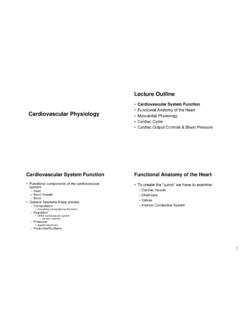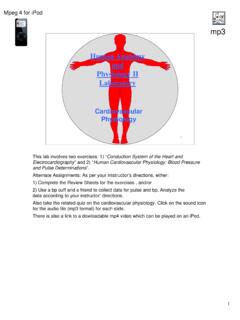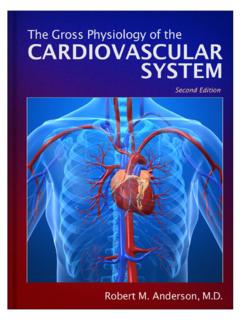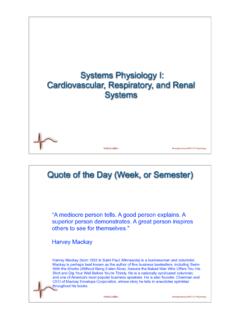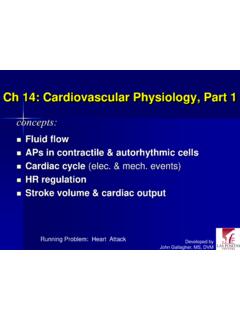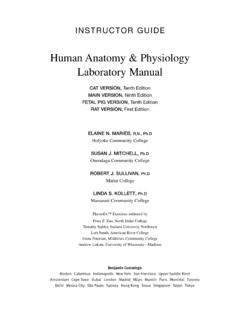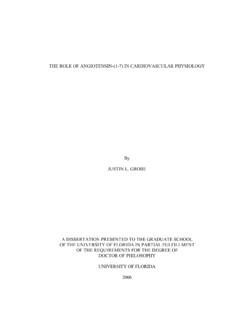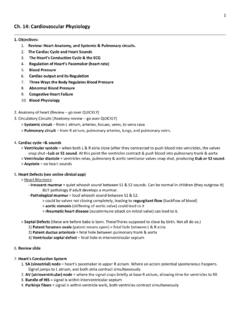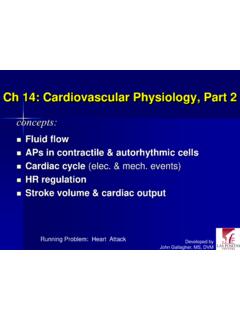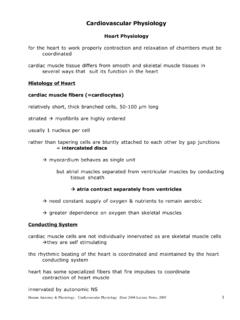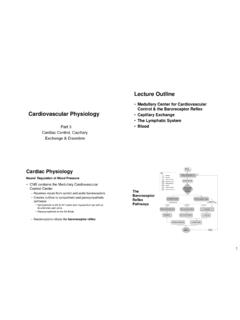Search results with tag "Cardiovascular physiology"
PhysioEx Lab 6 (Cardiovascular Physiology) - Amazon S3
s3.amazonaws.comPhysioEx Lab 6 (Cardiovascular Physiology) Due Date: Friday, January 25, 2013 Perform the experiments in PhysioEx lab 6 (Cardiovascular Physiology). Provide the results requested, and answer the questions, for each of the following activities. There are a total of 25 marks.
Functional Anatomy of the Heart Cardiovascular Physiology
www.tplagge.net1 Cardiovascular Physiology Lecture Outline • Cardiovascular System Function • Functional Anatomy of the Heart • Myocardial Physiology • Cardiac Cycle • …
Human Anatomy and Physiology II Laboratory - Class Videos
www.classvideos.net1 1 Human Anatomy and Physiology II Laboratory Cardiovascular Physiology This lab involves two exercises: 1) “Conduction System of the Heart and Electrocardiography” and 2) “Human Cardiovascular Physiology: Blood Pressure and Pulse Determinations”.
The Gross Physiology of the Cardiovascular System
cardiac-output.info2 │ Introduction After heart transplantation, without nerve supply to the heart or artificial pacing, the cardiac output and pulmonary/systemic blood volume balance remain normal. In the absence of heart failure, an increase in arterial resistance does not reduce cardiac output. An overall concept of cardiovascular physiology should accommodate these
Systems Physiology I: Cardiovascular, Respiratory, and ...
sci.utah.eduFeatures of Cardiovascular Physiology –Blood is thicker than water (it is a suspension of particles) –Blood vessels are not pipes (walls are elastic, contractile) –The heart is a "permissive" pump (follows rather than leads) –Most heart failure is electrical not mechanical in origin
Frog Cardiovascular Physiology - Welcome to Biology!
cherylchowbiology.weebly.comFrog Cardiovascular Physiology 79 (a) One-second time line (b) One-second time line Atrial systole Ventricular systole Ventricular diastole Normal systole Extrasystole Compensatory pause FIGURE 6.2 Recording of contractile activity of a frog heart. (a) Normal heartbeat. (b) Induction of an
Ch 14: Cardiovascular Physiology
lpc1.clpccd.cc.ca.usBlood Flow Why does blood flow through cardiovascular system? (teleological vs. mechanistic answers) Teleological: Because diffusion is too slow to support a large and complex organism Mechanistic: Because the contractions of the heart produce a hydrostatic pressure gradient and the blood wants to flow
Human Anatomy & Physiology Laboratory Manual
faculty.ung.eduExercise 28A Role of Thyroid Hormone, Pituitary Hormone, Insulin, and Epinephrine: Wet Lab 172 Exercise 29A Blood 179 Exercise 30 Anatomy of the Heart 188 Exercise 31 Conduction System of the Heart and Electrocardiography 194 Exercise 32 Anatomy of Blood Vessels 198 Exercise 33A Human Cardiovascular Physiology: Blood Pressure and Pulse Determinations …
THE ROLE OF ANGIOTENSIN-(1-7) IN CARDIOVASCULAR …
ufdcimages.uflib.ufl.eduthe role of angiotensin-(1-7) in cardiovascular physiology by justin l. grobe a dissertation presented to the graduate school of the university of florida in partial fulfillment
The Role of Venous Return in Critical Illness and Shock ...
emcrit.orgAn approach to cardiovascular physiology that incorporates both cardiac and vascular elements may be more useful to intensiv- ists than one that focuses exclusively on LV physiology.
Ch. 14: Cardiovascular Physiology - people.fmarion.edu
people.fmarion.edu2 8. Measuring Heart’s onduction System with EKG > P wave = when atria contract > QRS wave = when ventricles contract > T wave = when ventricles relax > there are normal time intervals between these events. Slower or faster intervals = problem!
Ch 14: Cardiovascular Physiology - Las Positas College
lpc1.clpccd.cc.ca.usThe Heart as a Pump (p477) Communication starts in autorhythmic cells in the SA node (the Pacemaker) Move from events in single cell to events in whole heart Cardiac cycle 1. electrical events 2. mechanical events Electrical conduction in heart coordinates contraction
Introduction to Cardiovascular Physiology
www.medicine.emory.eduRelationships among the vascular beds • Flow is constant in each segment, so velocity and area are inversely related • Pressure loss occurs mainly at the small arterioles, the resistance vessels
Cardiovascular Physiology - Austin Community College District
www.austincc.eduHuman Anatomy & Physiology: Cardiovascular Physiology Ziser 2404 Lecture Notes, 2005 1 Cardiovascular Physiology Heart Physiology for the heart to work properly contraction and relaxation of chambers must be
Cardiovascular Physiology -3 - tplagge.net
www.tplagge.net1 Cardiovascular Physiology Part 3 Cardiac Control, Capillary Exchange & Disorders Lecture Outline • Medullary Center for Cardiovascular Control & the Baroreceptor Reflex • Capillary Exchange • The Lymphatic System • Blood Cardiac Physiology
Cardiovascular Pharmacology - McGill University
www.mcgill.caCARDIOVASCULAR PHYSIOLOGY, PHARMACOLOGY, AND MOLECULAR BIOLOGY 120 of blood in the splanchnic capacitance system. Mesenteric blood volume increases as ventricular size, ventricular pressures, and intrapericardial pressure decrease. NTG increases the distensibility and conductance of large arteries without chang-
Cardiovascular Physiology - Jones & Bartlett Learning
samples.jbpub.comatrium via the vena cava (Figure 7.1). Cardiac Muscle: Cellular Level of Organization At the tissue level, cardiac muscle resembles skeletal muscle, in that it contains regular arrays of thick filaments (myosin) and thin filaments (actin and associated regulatory proteins) arranged within sarcomeres, bounded by Z disks.
Similar queries
PhysioEx lab 6 Cardiovascular Physiology, Amazon S3, Functional Anatomy of the Heart Cardiovascular Physiology, Cardiovascular Physiology, Cardiovascular, Functional Anatomy of the Heart, Physiology, Human Anatomy and Physiology II Laboratory, Human Anatomy and Physiology II Laboratory Cardiovascular Physiology, Introduction, Ch 14: Cardiovascular Physiology, Venous Return in Critical Illness, Austin Community College District, System, Vena cava

